Know the Etymology: 27
Place Name of the Day: Saturday, 13 February 2016
Kaṟuvāk-kāṭu/ Kuruńdu-vatta/ Cinnamon Gardens
கறுவாக்காடு, குருந்து₃வத்த
Kaṟuvāk-kāṭu/ Kuruńdu-vatta/ Cinnamon GardensKaṟuvā+kāṭu
Kuruńdu+vatta
The cinnamon forest
The cinnamon gardens or grove
| Kaṟuvā | cinnamon, Cinnamomum zeylanicum (Eezham Tamil); the Tamil term probably comes from the pungent-sweet taste of the inner bark; Kāṟal: pungency (Tamil, DED 1504); Kār: to be pungent, acrid, hot to the taste (Tamil, DED 1466); Kārppu, Kāram: pungency (Tamil, DED 1466); Kāḻ: to be pungent, acrid (Tamil, DED 1492); Kāḻppu: pungency (Tamil, DED 1492); Ḻ/ Ṟ interchange possible; Kaṟi: (verb) to be pungent (Tamil, "Kaṟiyum maa miḷaku" Campantar Tēvāram, 3: 9: 4); (noun) pepper, spices or condiments generally, curry (Tamil, DED 1391, 1466) |
| Kuruńdu | cinnamon, Cinnamomum zeylanicum (Sinhala); the Sinhala term probably comes from the spicy inner bark which is red-brown in colour, or from the leaf shoots of the tree which are conspicuously bright red; Kuruti: red colour, blood (Tamil, DED 1788, Kuṟuntokai, 1: 3-4); Kuru: colour (Tamil, Caṅkam diction, Aiṅkuṟunūṟu, 24: 8); Kurāl: red-brown colour (Tamil, DED 1776, Kalittokai, 104: 12); Guru: mixture of red chalk (Sinhala); Kuruvinda: ruby (Sanskrit, CDIAL 3328) |
| Davul-Kuruńdu | a variety of Cinnamomum zeylanica (Sinhala, Clough) |
| Pẹni-kuruńdu | sweet or cultivated cinnamon (Sinhala, Clough) |
| Kaṭu-kuruńdu | a prickly plant used for fences, Scolopia crenata (Sinhala, Clough); Kaṭu: thorny, pungent, fierce, hot, envious impetuous (Sinhala); Kaṭu: (verb) to throb and pain as from sting, venomous bite, prick etc., be pungent, be angry, be indignant; (noun) bitterness, pungency, poison, astringency, severe, cruel, harsh, extreme (Tamil, DED 1135); Kaṭu: pungent, bitter (Sanskrit, CDIAL 2641); Kaṇṭa: thorn (Sanskrit, Pali, CDIAL 2668); Kuruńdu: probably of comparable attributes with cinnamon such as the leaves or because of its red wood. See box on Kuruńdu |
| Kuruntu | also Kuruntam: wild lime, Atalantia, Atalantia, racemosa, Atalantia missionis (Tamil, DED 1789); Mayilaṭik-kuruntu: a type of Kurunthu the leaves of which resemble the feet of peacock, Trichillia spinosa (Tamil); Kurunnu: Trichillia spinosa (Malayalam DED 1789) |
| Kāṭu | forest, jungle, desert, paddy field (Tamil, DED 1438); Kaṭam, Kaṭaṟu: forest, difficult path (Tamil, DED 1438); cognates in 15 Dravidian languages; Kaḍa, Kaḍu, Kaḍuva, Kaḍi: forest (Sinhala, Sorata); Kāḍu: treeless alkaline stretch (Sinhala, see the desert meaning for Kāṭu in Tamil) |
| Vatta | site, place, land; place where trees, plants etc. are cultivated; garden, place of residence consisting of a garden or grove; residential place (Sinhala, Sorata, Clough). See column 61 |
Kaṟuvā, Kuruńdu or cinnamon was the most important spice that attracted the Portuguese to the island in 1505 CE. It is said that the choice of Colombo as colonial headquarters by the Portuguese and the Dutch was due to the cinnamon growing hinterland.
Kaṟuvā is essentially a term of Eezham Tamil usage and this is perhaps the only Dravidian term found in Tamil for cinnamon.
The other term Ilavaṅkap-paṭṭai used in Tamil Nadu for cinnamon is the suffix Paṭṭai (bark) added to the prefix Ilavaṅkam, which actually means clove in Sanskrit (CDIAL 10977) and in Tamil (early usage noticed in Perungkathai, 50: 32-33, c. 10th century CE).
The Eezham Tamil word Kaṟuvā is related to the Tamil/ Dravidian term Kāṟal (DED 1504), meaning pungency, the taste of Kaṟuvā.
The related terms in Tamil/ Dravidian are Kaṟi, which as verb and noun connected to pungency (DED 1391, 1466), and Kāral, Kārppu, Kārvu, Kāram etc., from the verb Kār, meaning to be pungent, acrid or hot to taste (DED 1466). Retroflex Ṟ is often retained or preferred in Eezham Tamil usages.
Another related term Kāḻppu in Tamil/ Dravidian (DED 1492, Ḻ/ Ṟ interchange), from the verb Kāḻ, not only means pungency but also means the thickening of the tongue from the taste, an effect typically felt in chewing cinnamon.
* * *The Sinhala term Kuruńdu for cinnamon seems to have come either from the conspicuously bright red leaf shoots of the tree or the reddish brown inner bark obtained from the tree.
Note the terms Kuruvinda for ruby in Sanskrit (CDIAL 3328) and Guru for mixture of red chalk in Sinhala.
Corresponding Tamil terms, listed as Dravidian, are Kuruti, meaning red or blood (DED 1788) and Kurāl meaning reddish brown (DED 1776). The root Kuru itself means colour in Caṅkam Tamil diction.
Kuruńdu is noticed as the name for a few species of trees and bushes in Sinhala. There are Davul-kuruńdu (a wild variety of cinnamon), Pẹni-kuruńdu (sweet cultivated variety) and Kaṭu-kuruńdu (a prickly bush used for fences).
A corresponding term Kuruntu in Tamil, which also has varieties such as Mayilaṭik-kuruntu, stands for wild lime. Kuruntu and Kuruntam as tree names could be found in the Caṅkam diction (Kuṟuntokai, 148: 3-4; Aiṅkuṟunūṟu, 44: 9), and in the meaning of wild lime they are listed as Dravidian (DED 1789).
See boxes for the etymology of Kāṭu meaning forest and vatta meaning grove. They are discussed in the other columns.
* * *Kaṟuvāk-kāṭu, Kuruńdu-vatta and
Cinnamon Gardens are respectively the Tamil, Sinhala and English names of the same place in Colombo city. The place was once a cinnamon plantation.
Kuruńdu-vatta as a Sinhala place name is found in many places: Homagama division, Colombo district; Thimbirigasyaya division, Colombo district; Mirigama division, Gampaha district; Kalutara division, Kalutara district; Yatinuwara division, Kandy district; Balapitiya division, Galle district; Galle Four Gravets division, Galle district and Okewala division, Hambantota district
* * *Some related place names:
Kaṟuvā: (Tamil):
Kaṟuvāc-cōlai: The cinnamon grove; Kōppāveḷi village, Eravoorpattu, Batticaloa.
Kaṟuvāk-kēṇi: The constructed pond in the locality of Kaṟuvā trees; Koralaippattu, Batticaloa district.
* * *
Kuruńdu (Sinhala):
Kuruńdu-hēna: The shifting cultivation field in the locality of cinnamon trees; Wattala, Gampaha; Dompe, Gampaha.
Ēkala-kuruńdu-vatta: The cinnamon garden at Ēkala; Ja-Ela, Gampaha
Kuruńdu-golla: The cinnamon grove or forest; Harispttuwa, Kandy; Uva Paranagama, Badulla.
Kuruńdu-gaha-maḍa: The muddy land or paddy field in the locality of cinnamon trees; Harispattuwa, Kandy.
Kuruńdu-oya: The stream or river passing through cinnamon trees; Walapane, Nuwara Eliya
Kuruńdu-gaha Hẹtẹkma: The highway stage resting-place by the side of a Kuruńdu tree; Karandeniya, Galle.
Kuruńdu-potha: The range of cinnamon trees; Bingiriya, Kurunegala.
Kuruńdu-kuṁbura: The paddy fields in the locality of cinnamon trees; Panduwasnuwara West, Kurunegala.
Kuruńdu-vẹva: The tank in the locality of cinnamon trees; or the tank in the locality of wild lime trees; Thalawa, Anuradhapura.
* * *
Kaṭu-Kuruńdu:Kaṭu-kuruńdu-vatta: The grove of Kaṭu-kuruńdu shrubs; Ratmalana, Colombo.
Kaṭu-kuruńdu-gaha-landa: The high-ground low jungle of Kaṭu-kuruńdu shrubs; Beruwala, Kalutara.
* * *
Kuruntu/ Kuruntaṉ: (Tamil)
Kuruntaṉ-kuḷam: The tank in the locality of wild lime trees; Manthai West, Mannar.
Kuruntaṉ-kāṭu: The jungle of wild lime trees; Karaithuraippattu, Mullaiththeevu.
Kuruntaṉ-kaṇṭu: The part of wild lime trees; Karaithuraippattu, Mullaiththeevu
Kuruntu-malai: The hillock of wild lime trees; Thannimurippu, Mullaiththeevu district
Kuruńdan-kuḷama: from Kuruntaṇ-kuḷam: The tank of Kuruntaṉ trees; Galgamuwa, Kurunegala; Mihinthale, Anuradhapura.
* * *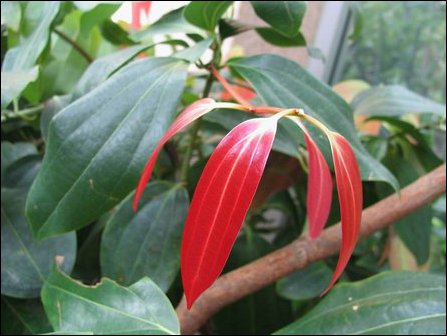
Cinnamomum zeylanicum: foliage [courtesy: newbotany.com]
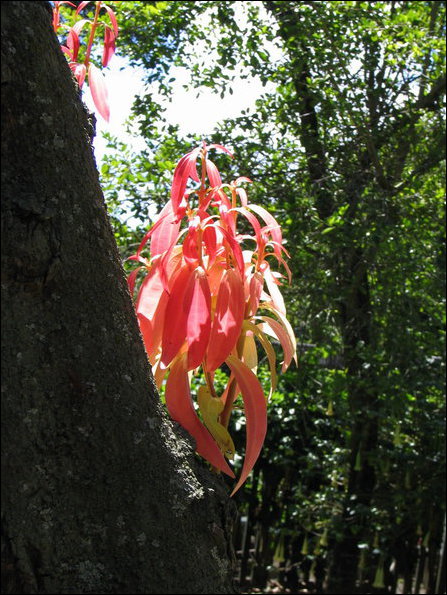
Cinnamomum zeylanicum: the tender leaves of a shoot [courtesy: newbotany.com]

Cinnamomum zeylanicum: a young plant [courtesy: montosogardens.com]
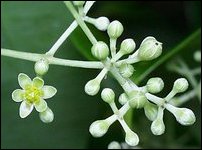
Cinnamomum zeylanicum: blossoms [courtesy: botit.botany.wisc.edu]
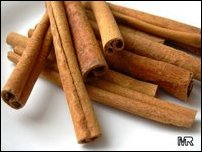
The spice, peeled from the bark of cinnamon. [courtesy: toptropicals.com]
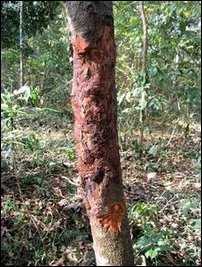
Cinnamomum zeylanicum: a stem peeled of its bark for the spice [coutesy: phyto-generation.com]

Cinnamomum: a matured tree
Previous columns:













